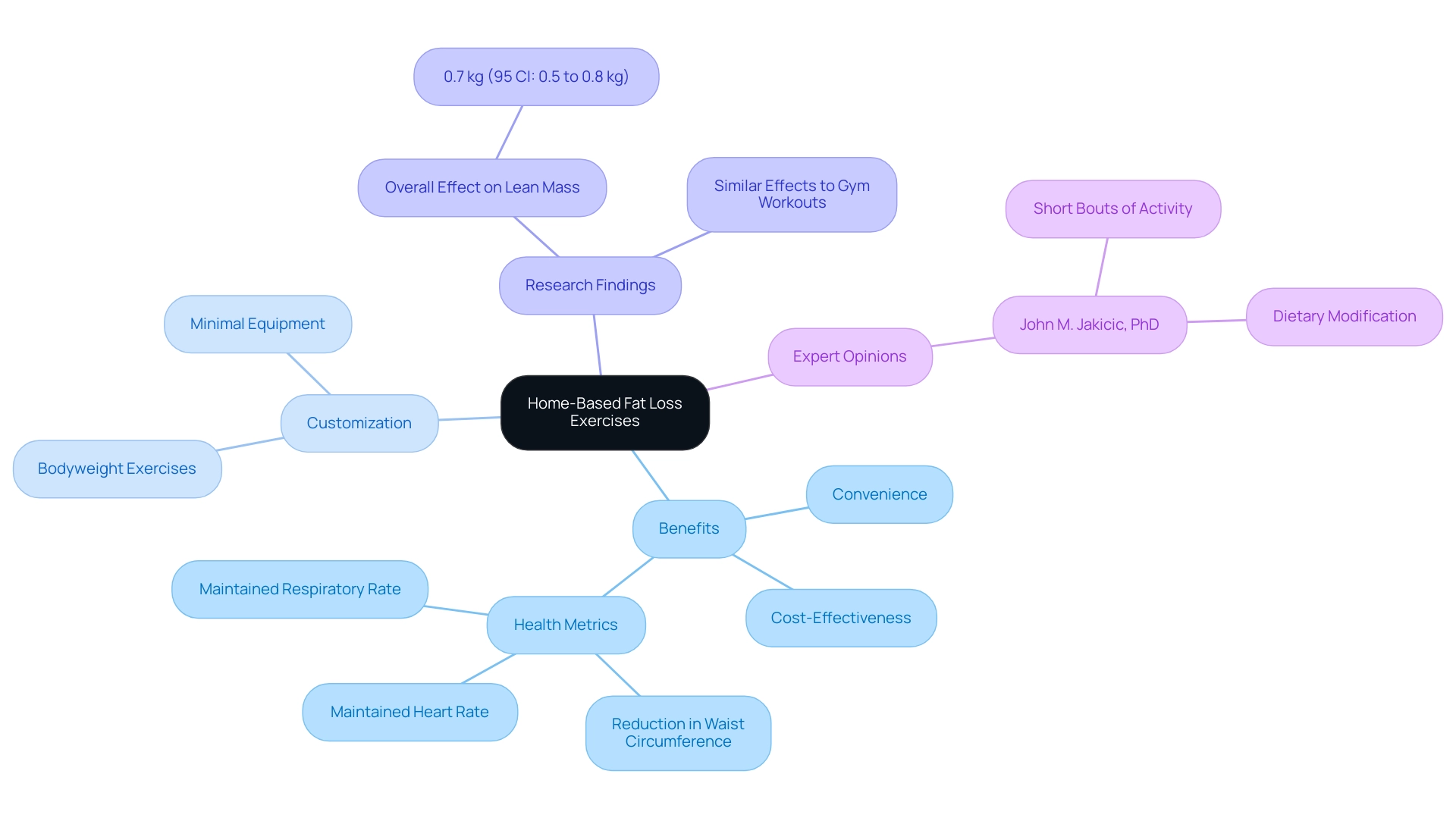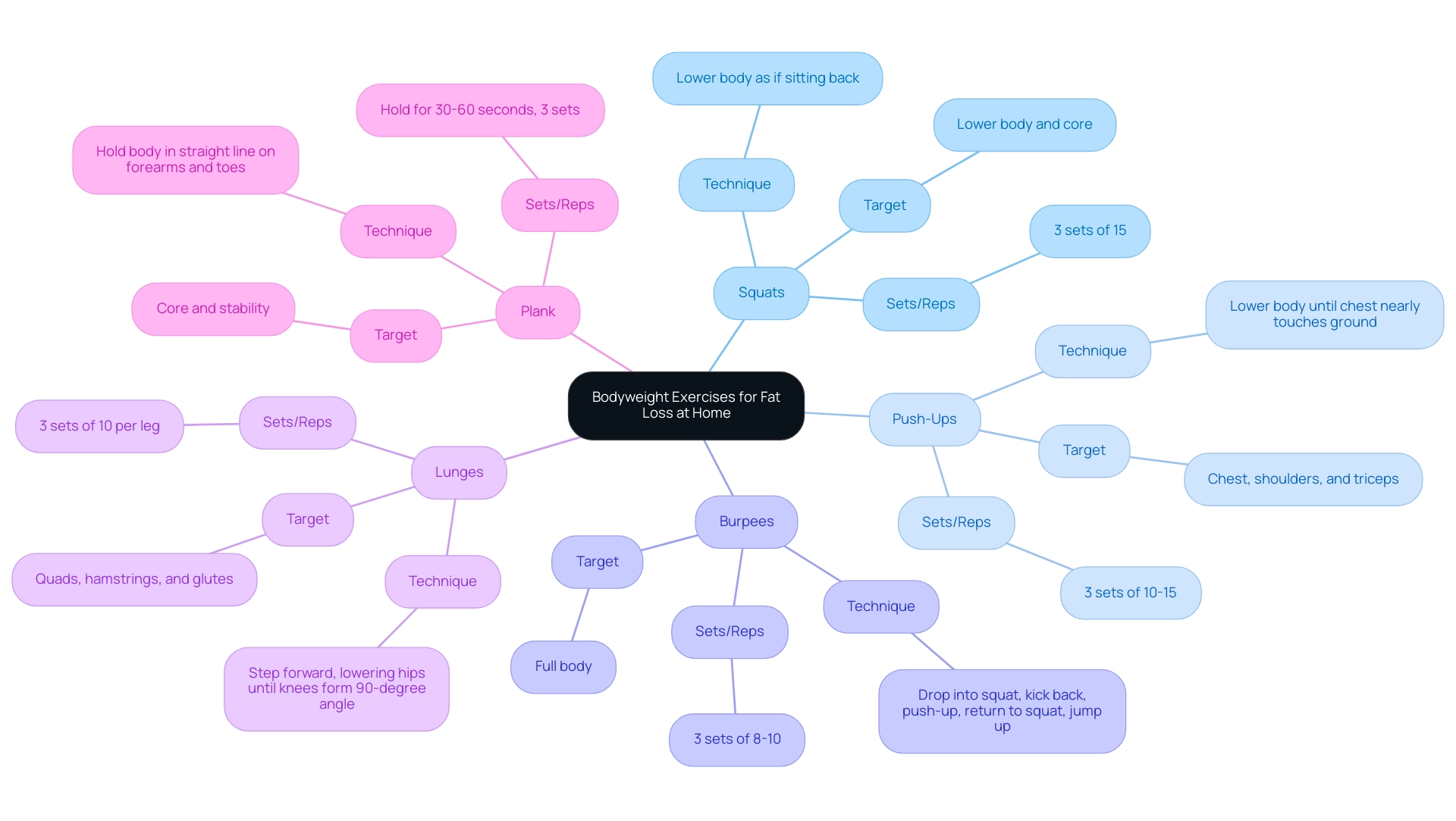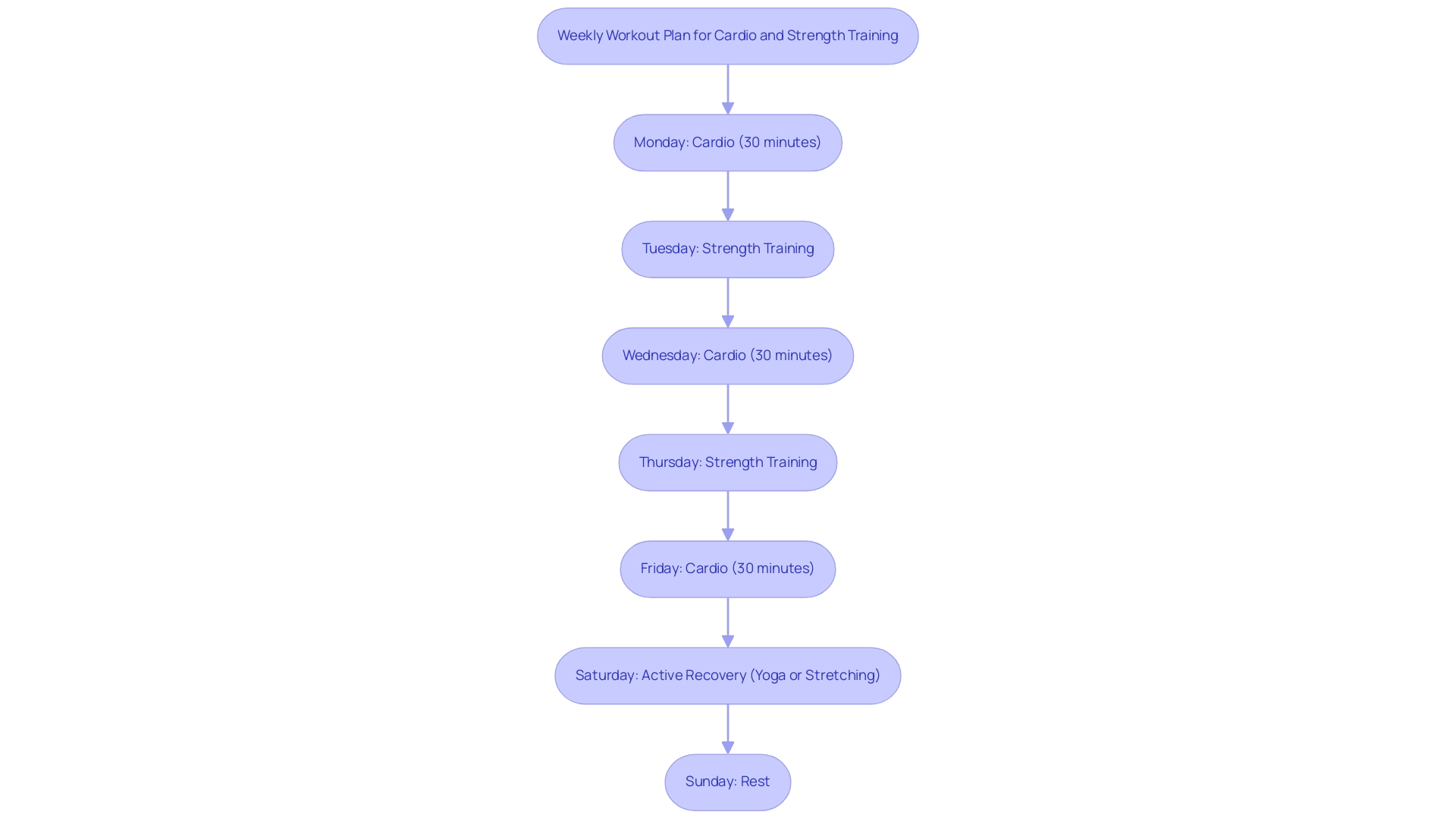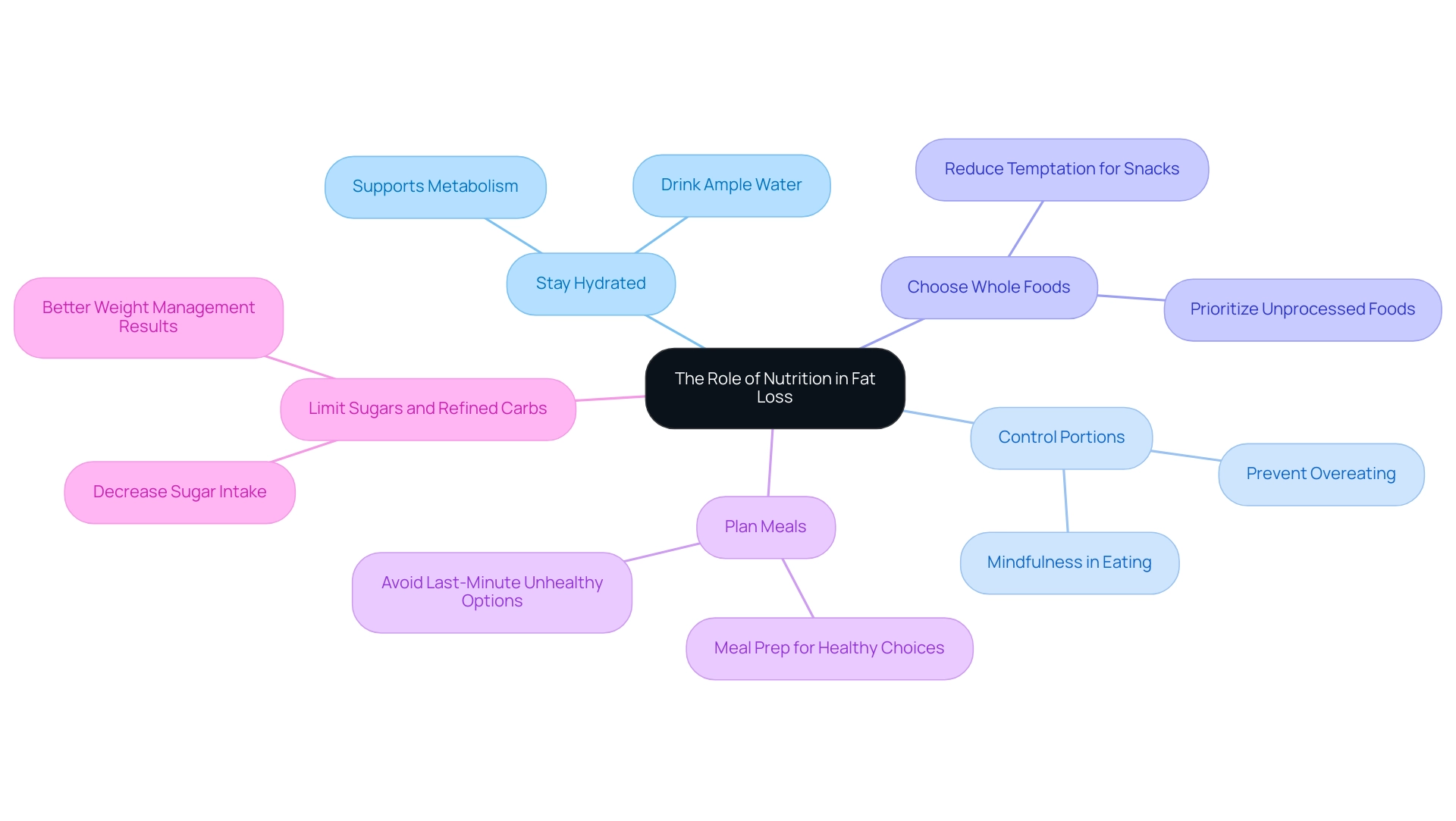Introduction
In a world where time is often a luxury, the pursuit of fitness can feel daunting, especially for those balancing busy schedules. However, home-based fat loss exercises offer a transformative solution, allowing individuals to seamlessly integrate fitness into their daily lives without the constraints of a gym.
By harnessing the power of bodyweight workouts and minimal equipment, anyone can embark on a journey to burn calories, build lean muscle, and enhance overall well-being—all from the comfort of their living room.
This article delves into effective strategies, including:
- Dynamic exercise routines
- The crucial role of nutrition
- Tips for maintaining motivation
These strategies empower readers to take charge of their health and achieve their fitness goals. Embracing these practices not only fosters individual wellness but also cultivates a culture of health within teams and communities, inspiring collective growth and vitality.
Introduction to Home-Based Fat Loss Exercises
Fat loss exercises at home provide a fantastic opportunity to seamlessly integrate fitness into your busy life, eliminating the need for a gym. These exercises can be carried out at your convenience, allowing you to customize each session to fit perfectly within your day. By focusing on bodyweight exercises and utilizing minimal equipment, you can perform fat loss exercises at home to effectively burn calories while building lean muscle right in your living room.
Notably, studies indicate that such exercises not only contribute to a reduction in waist circumference but also maintain key health metrics like heart rate and respiratory rate, with both home and gym routines demonstrating similar effects. Additionally, research shows an overall effect on lean mass of 0.7 kg, emphasizing the effectiveness of these routines. Embracing fat loss exercises at home not only saves precious time but also creates a comfortable, distraction-free environment where you can fully dedicate yourself to achieving your fitness goals.
As John M. Jakicic, PhD, aptly noted, the effectiveness of short bouts of physical activity is substantial, emphasizing that they can fit into even the busiest of schedules without compromising results. Moreover, the case study titled 'Future Directions for Home-Based Activity Programmes' suggests that incorporating a variety of activities may enhance engagement and enjoyment, leading to more effective home-based programs for adults living with overweight and obesity. This flexibility makes home workouts an ideal solution for anyone looking to enhance their well-being.

Effective Bodyweight Exercises for Fat Loss at Home
For individuals aiming to enhance fat loss exercises at home with restricted time, integrating bodyweight movements into your regimen can be both effective and efficient. Based on research by Wewege et al., fat loss exercises at home using bodyweight routines can be equally effective as conventional strength training for fat reduction, especially for those with excess weight or obesity. Furthermore, a balanced diet is essential, as the caloric intake for the resistance training group was recorded at 2,009 kcal per day.
Helen West, RD, emphasizes, "Bodyweight movements are fantastic fat loss exercises at home that engage multiple muscle groups while also elevating your heart rate."
To support your health initiatives and foster a culture of well-being among your team, consider integrating these standout options into your wellness programs:
- Squats: Position your feet shoulder-width apart, lower your body as though you're sitting back into a chair, and rise back up. Aim for 3 sets of 15 repetitions to effectively engage your lower body and core.
- Push-Ups: Begin in a plank position, lowering your body until your chest nearly touches the ground, then push back up. If needed, modify by using your knees. Target 3 sets of 10-15 repetitions to strengthen your chest, shoulders, and triceps.
- Burpees: Start standing, drop into a squat, kick your feet back into a plank, perform a push-up, return to squat, and jump up explosively. Strive for 3 sets of 8-10 repetitions; this full-body movement elevates your heart rate, offering an excellent cardio workout.
- Lunges: Step forward with one leg, lowering your hips until both knees form about a 90-degree angle. Alternate legs and aim for 3 sets of 10 repetitions per leg, targeting your quads, hamstrings, and glutes.
- Plank: Get into a plank position on your forearms and toes, keeping your body in a straight line. Hold for 30-60 seconds, repeating for 3 sets to strengthen your core and improve stability.
By incorporating fat loss exercises at home into your routine, you can demonstrate the importance of fitness, even in the busiest of schedules, while enhancing Foresight Health Coaching's personalized programs designed to create lasting lifestyle changes. Additionally, with our app-based delivery of personalized fitness coaching, you can easily track progress and stay motivated. Our corporate memberships also provide comprehensive wellness solutions that can be tailored to your organization’s needs, ensuring that your employees have access to the resources they need to thrive.

Combining Cardio and Strength Training for Optimal Results
For those seeking optimal fat loss exercises at home, combining cardio and strength training is crucial. Engaging in cardio exercises—whether it's jumping jacks, running in place, or dancing—raises your heart rate and effectively burns calories. Current guidelines recommend at least 150 minutes of moderate-intensity cardio each week to harness these benefits.
Complementing this with strength training, which can include bodyweight routines, is essential for building muscle and enhancing metabolism. Incorporate strength training at least twice a week, targeting different muscle groups during each session. Here's a sample weekly plan that balances both elements:
- Monday: Cardio (30 minutes)
- Tuesday: Strength training (bodyweight routines)
- Wednesday: Cardio (30 minutes)
- Thursday: Strength training (bodyweight routines)
- Friday: Cardio (30 minutes)
- Saturday: Active recovery (yoga or stretching)
- Sunday: Rest.
This dynamic combination not only promotes fat loss exercises at home but also enhances overall fitness and well-being, aligning with the latest recommendations on effective workout strategies. By embracing this dual approach, individuals can significantly enhance their health outcomes, with every 1% body fat reduction associated with a 3% to 8% decrease in the risks of developing cardiovascular disease factors such as hypertension and hypercholesterolemia. Just like the findings from the STRRIDE-AT/RT study highlight, which emphasize the effectiveness of integrating cardio and strength training, this approach can yield substantial benefits, ensuring both physical and mental wellness in a busy schedule.
Additionally, the updated scientific statement by Williams MA et al. underscores the significance of resistance training, further supporting the recommendation to include strength training in your fitness regimen.

The Role of Nutrition in Fat Loss
Nutrition is a cornerstone of effective fat reduction, playing a pivotal role in complementing your exercise efforts. Adopting a balanced diet that includes whole foods, lean proteins, healthy fats, and a wide array of fruits and vegetables can significantly enhance your results. Research indicates that diets such as Atkins, Weight Watchers, and Zone diets led to modest and comparable long-term weight reduction after one year, highlighting the significance of nutritional strategies.
Here are essential nutritional strategies to consider:
- Stay Hydrated: Consistent hydration is vital. Drinking ample water throughout the day supports metabolism and overall well-being, paving the way for more effective workouts and recovery.
- Control Portions: Mindfulness regarding portion sizes can prevent overeating, even with healthy foods. This practice is critical in maintaining a caloric deficit necessary for fat loss.
- Choose Whole Foods: Prioritize whole, unprocessed foods over sugary snacks and fast food options. These choices not only nourish your body but also keep you satiated longer, reducing the temptation to snack on empty calories.
- Plan Meals: Preparing healthy meals in advance can help you avoid the pitfalls of last-minute unhealthy choices. Meal prep guarantees that healthy choices are easily accessible, facilitating adherence to your objectives.
- Limit Sugars and Refined Carbs: Decreasing sugar consumption can significantly influence your fat reduction journey. Studies indicate that controlling these elements in your diet leads to better weight management results.
According to the National Weight Control Registry, successful long-term weight reduction maintenance involves engaging in high levels of physical activity and maintaining a consistent eating pattern, which are essential components of a nutritional approach. UOO substantially played a role in the discussion and planning of this project, its design, and how data were acquired, interpreted, and analyzed. By incorporating these nutritional habits into your daily routine, you can significantly enhance the effectiveness of fat loss exercises at home and move closer to achieving your goals.
Remember, each step towards healthier eating is a step towards a better version of yourself, inspiring those around you to do the same.

Staying Motivated: Tips for Consistency in Home Workouts
Maintaining motivation during exercise at home can certainly present difficulties, as emphasized by Justin Marston, who observed that 50% of consumers reported their at-home routines were not intense enough, faced challenges with consistency, and found it hard to remain motivated. However, with the right strategies, you can maintain consistency and achieve your fitness goals. Here are some powerful tips to help you stay on track:
- Set Clear Goals: Establishing specific, achievable goals adds purpose to your exercise. Whether it's enhancing strength or boosting endurance, having a target to strive for can greatly improve your concentration.
- Create a Schedule: Treat your exercise routine as a non-negotiable appointment in your calendar. By allocating time for physical activity, you emphasize its significance in your daily routine.
- Find a Fitness Partner: Teaming up with a friend or family member not only makes sessions more enjoyable but also keeps you responsible. Social support can be a game-changer in maintaining commitment.
- Track Progress: Utilize a journal or fitness apps to monitor your exercises. Celebrating small victories along the way can boost your motivation and remind you of the progress made.
- Mix It Up: Combat boredom by regularly trying new exercises or routines. This keeps things fresh and exciting, encouraging you to stay engaged.
- Reward Yourself: Establish a reward system for achieving milestones. Recognizing your efforts and treating yourself for reaching goals can significantly enhance your motivation.
Implementing these strategies can help you cultivate a sustainable home workout routine that incorporates fat loss exercises at home and promotes improved overall health. As highlighted in recent surveys, 78% of individuals cite health and wellness as their primary motivator for working out, with mental health and fitness progress following closely at 38%. Furthermore, the statistic that 85% of those aged 60 and older chose overall health and wellness as one of their main motivators underscores the importance of these strategies across different age groups. By setting clear intentions and maintaining consistency, you can inspire others to embrace a healthier lifestyle, contributing positively to their well-being.

Conclusion
Home-based fat loss exercises present a powerful opportunity for individuals to enhance their fitness without the constraints of a gym. By focusing on bodyweight routines and minimal equipment, anyone can effectively burn calories and build lean muscle from the comfort of their own home. The evidence shows that these workouts not only yield results similar to those achieved in traditional gym settings but also foster an environment conducive to personal growth and well-being.
Incorporating effective bodyweight exercises, blending cardio with strength training, and prioritizing nutrition are all essential components of a successful fat loss strategy. Simple yet impactful exercises such as:
- Squats
- Push-ups
- Lunges
can easily fit into busy schedules, while a balanced diet and mindful eating practices amplify these efforts. Staying hydrated, controlling portions, and planning meals are vital steps that support sustained progress and health.
Motivation is key to maintaining consistency in home workouts. Setting clear goals, creating a structured schedule, and finding accountability through workout partners can significantly enhance commitment. By tracking progress and celebrating achievements, individuals can cultivate a positive mindset that encourages long-term adherence to fitness routines.
Embracing home-based fitness not only benefits individual health but also nurtures a culture of wellness within teams and communities. As more people prioritize their well-being, a collective movement towards healthier lifestyles can emerge, inspiring others to join the journey. Now is the time to take action, integrate these strategies, and unlock the potential for transformation, both personally and within the wider community.




